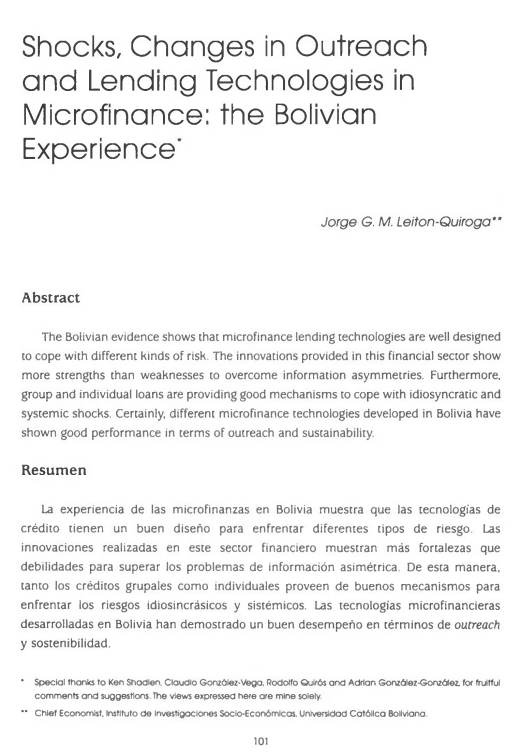Shocks, Changes in Outreach and Lending Technologies in Microfinance: the Bolivian Experience
DOI:
https://doi.org/10.35319/lajed.20078192Keywords:
Microfinance, NICT, TechnologyAbstract
The Bolivian evidence shows that microfinance lending technologies are well designed to cope with different kinds of risk. The innovations provided in this financial sector show more strengths than weaknesses to overcome information asymmetries. Furthermore, group and individual loans are providing good mechanisms to cope with idiosyncratic and systemic shocks. Certainly, different microfinance technologies developed in Bolivia have shown good performance in terms of outreach and sustainability
Downloads
References
Adams, Dale W. and J.D. von Pischke 1992. “ Microenterprise credit programmes: déjá vu". World Development 20. 1463-1470.
Allen, T and A Thomas. 2000. Poverty and Development Oxford University Press.
Amin, S . S Rai and G. Topa. 2003. "Does microcredit reach the poor and vulnerable? Evidence from northern Bangladesh" Journal of Development Economics 70. 59-82
Bardhan, P. and C. Udry. 1999. Development Microeconomics Oxford University Press
Besley, Timothy. 1994. “ How do market failures justify interventions in rural credit markets?". The World Bank Research Observer, vol 9. N° 1. 27-47.
Conning, J. 1999. “ Outreach, sustainability and leverage in monitored and peer- monitored lending".Journal of Development Economics, vol. 60. 51-77.
Deaton, Angus. 1997. The analysis of household surveys: A microeconometric approach to development policy Baltimore: John Hopkins University Press.
Dreze, J. P. Lanjouw and N. Sharma. 1998. Credit Chapter 9 in Economic Development in Palanpur over five decades Oxford Clarendon Press
El Diario . 2003. Microfinance: as opposed to the economic crisis, default rates are goingdown June 25th. La Paz-Bolivia. http://www.eldiario.net/noticias/nt030625/3_09ecnhtml
FONDESIF. 2001. From Financial NGO to Private Financial Fund - The Bolivian Case. Technical Note N° 1. june.
Gonzalez-Vega, C , F Prado-Guachalla and T Miller-Sanabria. 2002. El reto de las microfinanzas en America Latina: la visión actual. Corporación Andina de Fomento, Caracas, Venezuela. 2nd Edition
Gonzalez-Vega, Claudio. 2003. El manejo del riesgo idiosincrático y del riesgo sistémico en las microfinanzas. Presentation for Banco Solidario. April. 3rd to 7th, La Paz and Santa Cruz. Bolivia.
Gonzalez-Vega, Claudio and Jorge Rodriguez-Meza. 2002. La situación macroeconómica y el sector de las microfinanzas en Bolivia. Development Alternatives. Inc./Proyecto SEFIR. USAID/Bolivia. Cuaderno N° 1.
Gulli, Hege. 1999. Microfinance and Poverty-Questioning the conventional wisdom. Inter-American Development Bank-Sustainable Development Department.
Hanning, A. and S Wisniwski. 1999. Challenges of microsavings mobilization: Concepts and views from the field Consultative Group to assist the Poor.
Hulme, D. and M. Edwards. 1997. NGOs. States and Donors. An Overview. In NGOs. Statesand Donors: Too close for comfort?. New York: St. Martin's Press Inc.
International Monetary Fund. 1999. International Financial Statistics.
Leiton-Quiroga, Jorge G.M. 2000. Shocks de términos de intercambio y la balanza comercial. Thesis N°, 530. Bolivian Catholic University. La Paz-Bolivia.
Maurer, K. 1999. Bank Rakyat Indonesia (BRI): Case Study. Consultive Group to Assist the Poor.
Mckinnon, Ronald I. 1973. Money and capital in economic development. Washington. D C.: The Brookings Institution.
Morduch, Jonathan. 2000. The Microfinance Schism, World Development, vol. 28. N° 4. 617-629.
Morduch, Jonathan. 1998. The microfinance revolution. Mimeo, Harvard University.
Navajas, S. and C. Gonzalez-Vega. 1999. Innovación tecnológica en finanzas rurales: Financiera Calpia de El Salvador. Programa de Investigación BASIS en Centro América. The Ohio State University, Rural Finance Program.






